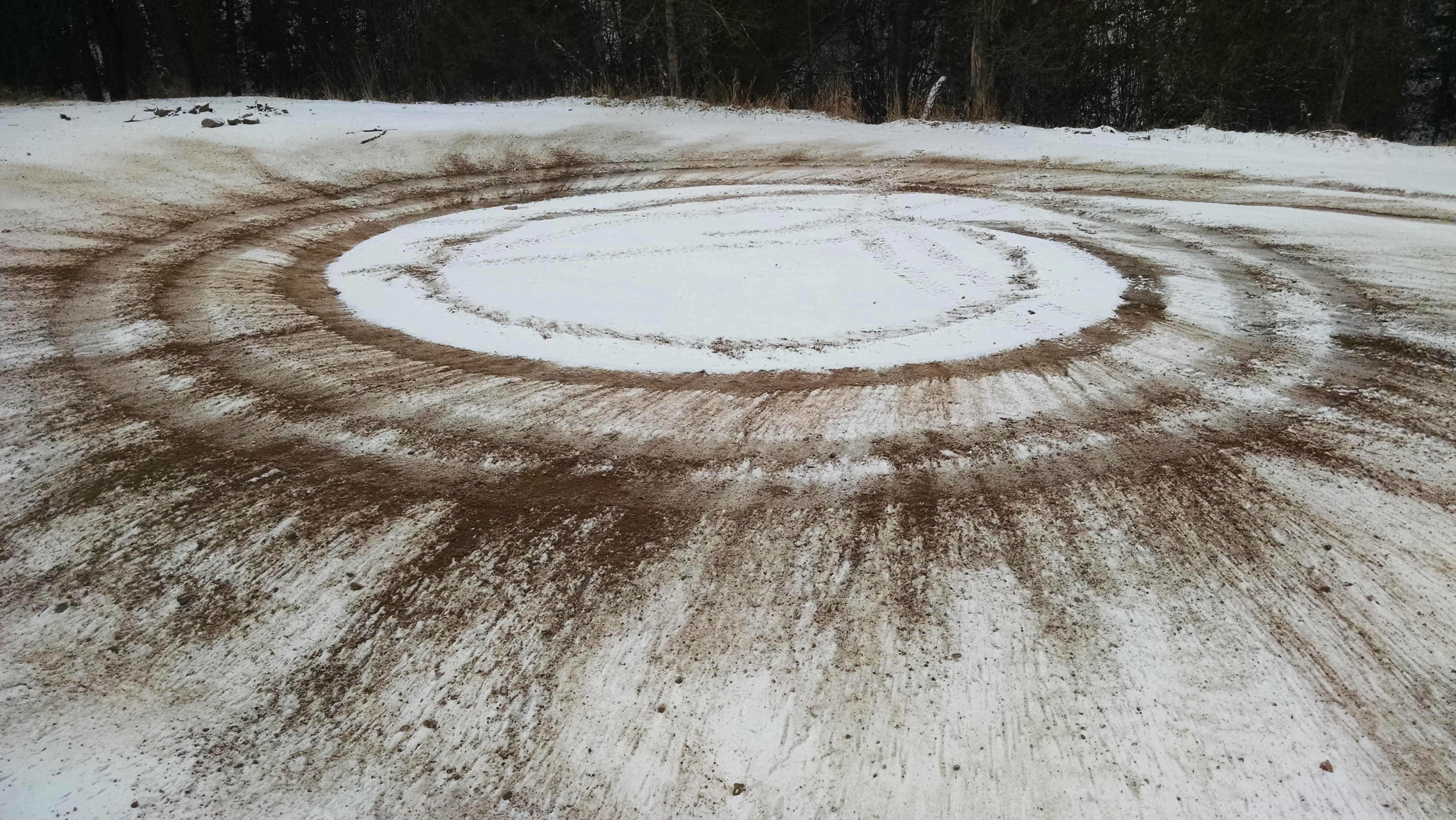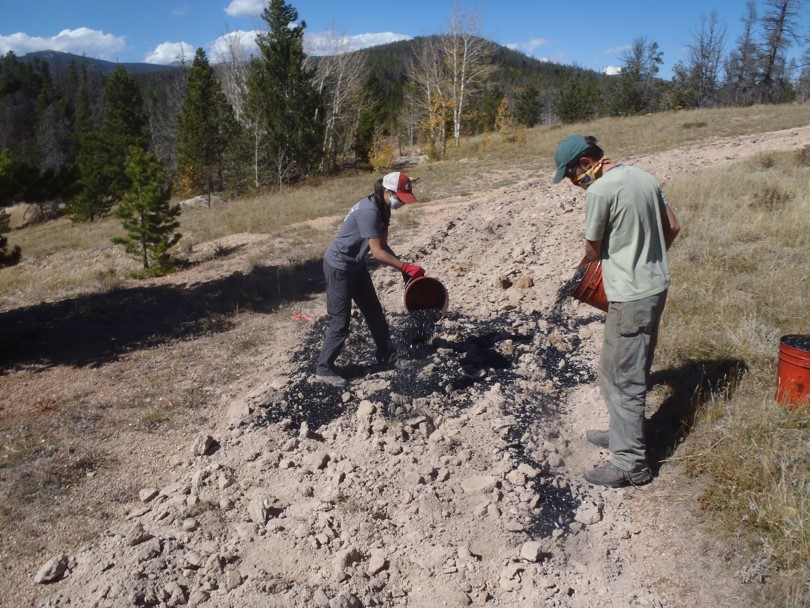
The Most Challenging Field Variable to Control for
By Matt Ramlow
Matt Ramlow is a PhD student with Dr. Francesca Cotrufo, researching the impacts of biochar soil amendments on managed ecosystems with the Bioenergy Alliance Network of the Rockies (BANR).
I pull up the snow dusted road to the gate of 7 Mile Creek Road and see that it’s open. A shot of anxiety reverberates through my body. Today is my first day heading back to my field sites after a 6 month winter hiatus. I know that while I was back in the lab and classroom this winter, this road had seen many other visitors, who came out here for many different reasons other than research. I decide to park my Subaru by the gate remembering the creek crossing. (I don’t feel like repeating my recent 5 hour ordeal trying to back out of the snow on an attempted snowshoeing trip a few weeks back.)

I grab my equipment and hike down the snow covered road enjoying the stillness on this cool March morning as the few light flakes begin to cover my tracks behind me. After 15 minutes of trekking I reach the staging area where the off-shooting roads have officially been declared “decommissioned”—in other words, roads officially off limits to vehicles intended to be restored to their natural state. However, I doubt any casual observer would come to the same conclusion. The structural barricades we had constructed when the road was first closed had all been run down over the past two winters. Not far from our failed attempt to shut off the road and restore the site to native vegetation I found a campfire ring with fresh logs lying within. This new campsite was pitched just a few yards from one of the treatment plots we had to abandon last year due to overuse. Not far beyond these relic plots stood a freshly place survey marker tagged with “Gold Rush Expeditions: Preserving Western Mining Heritage”. Then, to add to my fears, I looked ahead and saw the large boulder specifically positioned to prevent access to even more miles of “closed” forest above had been moved. I held my breath.
One of the challenges with field research is that you have very little control over all of the natural variability. Researchers studying experimental treatments across sites must do their best to account for and control for such variability. My advisors had cautioned me to include as many replicates as possible because you never know what might happen, and boy did that echo true! Last spring’s big surprise was showing up to find a lovely little stream that had decided my research plots were the path of least resistance along our Meadow Road site. All seven of the soil amendment treatments we added and meticulously sampled that previous fall had now been well mixed to the point that I could hardly tell my control plots from my mulch plots. While frustrating, I acknowledge this as my own rookie mistake: choosing my sites during the dry fall season and not properly considering the topography beforehand. Nonetheless, there was now one less replicate for my study. To make matters worse, the multiple shotgun shells I discovered in my plots closer to the road, along with the tire tracks and removal of the rebar I had used to mark my plot boundaries were, needless to say, unsettling. It felt like nature and society were conspiring to destroy my road restoration study and I needed to fight back.

So fight back we did! My field techs and I spent all of a good morning last spring erecting a barricade of rocks, logs and other debris to help shield off attacks from potential human threats to my research plots. My surviving plots were located down a dead end road segment not far from the access point on 7 Mile Creek Road. Our goal was to make this stretch of decommissioned road with our treatments as unattractive to potential off-roaders as possible. While anybody can clear debris to get access to more roads, we figured ‘who would waste their time clearing off a small section that didn’t even lead anywhere?’ How wrong we were. Off-roaders are a strange breed where certain obstacles can make the challenge all the more attractive to conquer, making it a fine balance to put up just the right amount of obstruction to make it perfectly unappealing.
Today as I rounded the small hill I was thrilled to see that our fortifications were still in-tact and my plots had managed to survive another winter. While there was too much snow to complete all of the sampling I spent the next few minutes making observations and resetting some of our soil temperature loggers that were accessible. That’s when I heard the rev of engines. To be honest I was a bit surprised that anybody else was out driving 7 Mile Creek Road this time of year. I was even more shocked to watch three jeeps drive not down the road but veer onto these “closed roads” right over my now long dead plots, skirt around the boulder and pass right on up to the roads above. I glanced over and saw an equally perplexed look of confusion on their faces wondering what in the hell was this guy doing out here with a Netbook and other instruments digging around in the dirt.
While part of me wanted to confront those off-roaders and tell them off for illegally driving up this decommissioned road, could I really blame them? They likely weren’t the first ones who drove over this road, reopening access while destroying my plots, and I guarantee they won’t be the last. Are they being irresponsible? Yes. Are they breaking the rules? Yes, although to be fair they may have not even realized it. Are they intentionally trying to systematically destroy the ecosystem and my research? Probably not. When it comes down to it this is all public land. Here the US Forest Service has the challenge of protecting the watershed while balancing the recreational and natural resource demands for the area. As a researcher it is easy to get fixated on my measurements, protecting the integrity of my sites and my study, but in doing so it’s just as to easily loose sight of the big picture.
Starting in the 1970s the US Forest Service began a broad mission to reduce the road density within our national forests. Underutilized forest roads promote erosion and runoff contributing to stream sedimentation, alter hillslope hydrology, provide access points for noxious weeds, all while requiring costly continual maintenance. Typical treatments to decommission roads involves decompacting the soil, recontouring the surface based on the natural topography and preventing access. In ecologically sensitive areas, additional soil amendments can be used to promote vegetation regrowth, to help stabilize the soil and to promote native species. Such treatments can be considerable work and require additional resources, therefore it is important to evaluate which efforts maximize outcomes while minimizing inputs. Our study compares the effectiveness of different soil amendments in reestablishing vegetation and their environmental impact.
For road decommissioning efforts to be successful and an efficient use of resources they must be carefully planned with broader land management goals. Our role as researchers is to provide objective analysis that decision makers can then use to evaluate the trade-offs between these values and hopefully arrive at a management plan that the public can agree to. While our research addressed which treatments are most effective at supporting revegetation, additional factors such as recreational demand by off-roaders to select sites that are truly underutilized and visitor education of the issues posed by overuse are needed to address the broader problems. We can most effectively manage our lands by identifying and efficiently treating roads no longer heavily used and weighing the recreational value versus the ecological value along roads that are.
As frustrating as losing some of my plots may be, it serves as an important reminder of how this research is just one small facet of the bigger issue and that human impact can be one of the hardest field variables to control for.
Connect with EcoPress on social media! Like us on Facebook and follow us on Twitter, @nrel_science, for more stories and news.